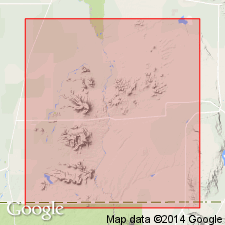
- Usage in publication:
-
- Wildhorse Member
- Modifications:
-
- Named
- Dominant lithology:
-
- Mudflow
- Breccia
- Lava
- AAPG geologic province:
-
- San Luis basin
Summary:
Named as the lower (of 3) member of Conejos Formation for exposures at north end of Wildhorse Ridge, 1.7 mi east of La Sauses [also spelled Lasauses on some maps], Costilla Co, CO in the San Luis basin. Exposures found only in lower part of ridge. No type locality designated. Geologic map. Maximum thickness about 650 ft. Consists of mudflows and basaltic-appearing flow breccias grading upwards into autobreccia and lava flows. Lava flows dominate upper part. Moderately to well-sorted, cross-bedded tuffaceous sediments of fluvial origin present within member. These tuffaceous sediments were derived from adjacent volcanic rocks. The fragments in the lower part of member are homogeneous, subangular to angular, dense to vesicular, and poorly sorted; they are up to 1 1/2 ft in size. Phenocryst (augite and andesite) content ranges from 10 to 40 percent. Upper flows are glomeroporphyritic, contain minor hypersthene and biotite. Chemically, the rocks are mafic rhyodacite. Lower contact covered by alluvium. Underlies La Sauses Member of Conejos unconformably. Oligocene age.
Source: GNU records (USGS DDS-6; Denver GNULEX).
For more information, please contact Nancy Stamm, Geologic Names Committee Secretary.
Asterisk (*) indicates published by U.S. Geological Survey authors.
"No current usage" (†) implies that a name has been abandoned or has fallen into disuse. Former usage and, if known, replacement name given in parentheses ( ).
Slash (/) indicates name conflicts with nomenclatural guidelines (CSN, 1933; ACSN, 1961, 1970; NACSN, 1983, 2005, 2021). May be explained within brackets ([ ]).

